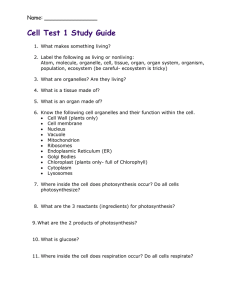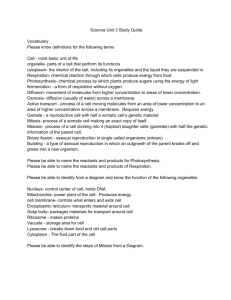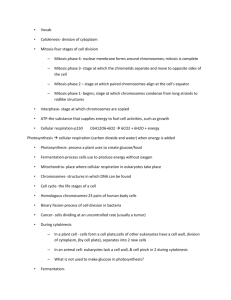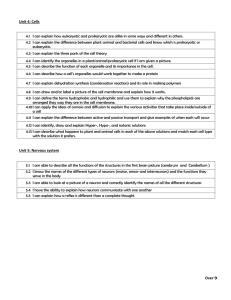Midterm Review sheet
advertisement
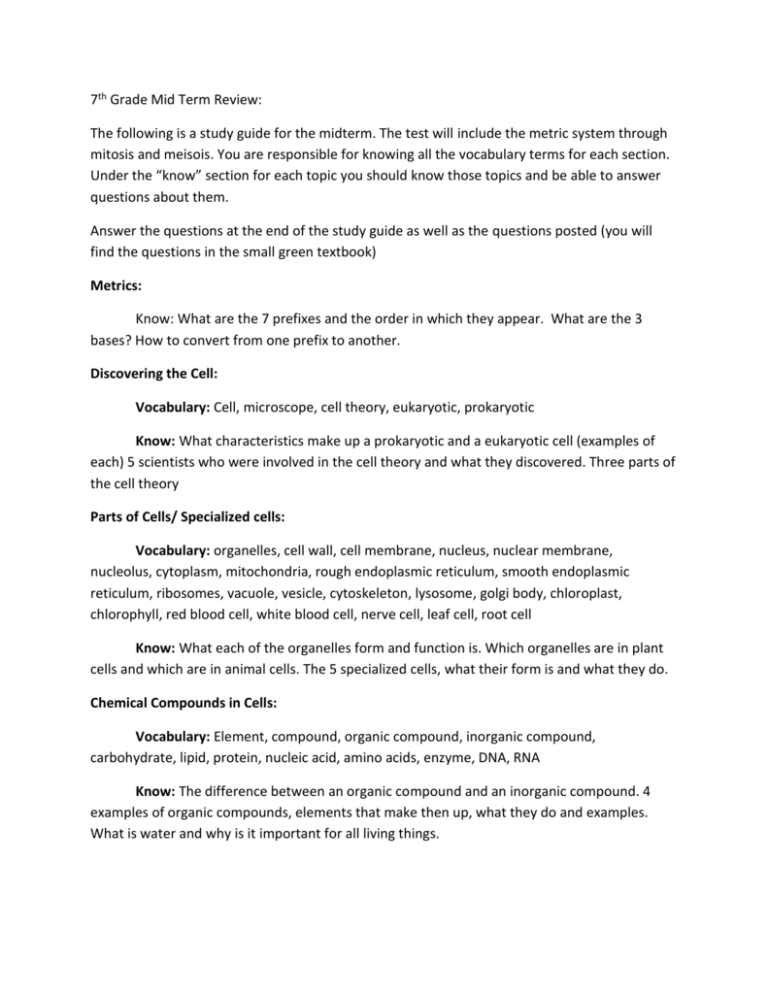
7th Grade Mid Term Review: The following is a study guide for the midterm. The test will include the metric system through mitosis and meisois. You are responsible for knowing all the vocabulary terms for each section. Under the “know” section for each topic you should know those topics and be able to answer questions about them. Answer the questions at the end of the study guide as well as the questions posted (you will find the questions in the small green textbook) Metrics: Know: What are the 7 prefixes and the order in which they appear. What are the 3 bases? How to convert from one prefix to another. Discovering the Cell: Vocabulary: Cell, microscope, cell theory, eukaryotic, prokaryotic Know: What characteristics make up a prokaryotic and a eukaryotic cell (examples of each) 5 scientists who were involved in the cell theory and what they discovered. Three parts of the cell theory Parts of Cells/ Specialized cells: Vocabulary: organelles, cell wall, cell membrane, nucleus, nuclear membrane, nucleolus, cytoplasm, mitochondria, rough endoplasmic reticulum, smooth endoplasmic reticulum, ribosomes, vacuole, vesicle, cytoskeleton, lysosome, golgi body, chloroplast, chlorophyll, red blood cell, white blood cell, nerve cell, leaf cell, root cell Know: What each of the organelles form and function is. Which organelles are in plant cells and which are in animal cells. The 5 specialized cells, what their form is and what they do. Chemical Compounds in Cells: Vocabulary: Element, compound, organic compound, inorganic compound, carbohydrate, lipid, protein, nucleic acid, amino acids, enzyme, DNA, RNA Know: The difference between an organic compound and an inorganic compound. 4 examples of organic compounds, elements that make then up, what they do and examples. What is water and why is it important for all living things. Cell and its Environment: Vocabulary: Selectively permeable, active transport, passive transport, diffusion, osmosis, hypotonic, hypertonic, isotonic, facilitated diffusion, engulfing, endocytosis, exocytosis Know: What diffusion and osmosis are. EGG LAB(what happened to each egg and why) How substances flow into or out of cells based on the concentration of materials inside and outside of them. Photosynthesis: Define Vocabulary – photosynthesis, autotroph, heterotroph, pigments, chlorophyll, stomata, chloroplasts, Know: equation for photosynthesis, how leaves get energy, Why do living things need energy, stages of photosynthesis, Where energy comes from. Respiration: Define Vocabulary – respiration, fermentation (alcoholic and lactic acid) Know: Equation for respiration, what respiration is, differences between respiration and photosynthesis, types of fermentation, How respiration stores energy, stages of respiration. Cell Division: Mitosis: Define Vocabulary – cell cycle, interphase, replication, mitosis, chromosomes, cytokinesis, spindle fibers, centrioles, sister chromatids, prophase, metaphase, anaphase, centromere, chromatid, nuclear membrane, telophase, nucelous, asexual reproduction, diploid, budding, regeneration, fission Know: What happens in the stages, cell cycle, what chromosomes are, be able to identify and label pictures of stages, what spindle fibers do, results of mitosis Answer the following questions: 1. Convert the following problems: a. 3 km= ______ m b. .45cg = _____ hg c. 520 L = _____ mL d. 9.31 dkL= ______ dL e. 56.97 g = ______ mg f. .245 km = _____ dkm 2. What is a prokaryotic cell? What is a eukaryotic cell? 3. Which organelle does a red blood cell not contain, why? 4. What would happen to a muscle cell if it lost mitochondria? 5. If a diploid tomato cell has 24 chromosomes, how many chromosomes will the tomato’s sex cells have? Answer the following questions in the Review and Assessment starting on page 39 in the textbook. Concept map on page 39 and questions 1-22, 24-26 Answer the following questions in the Review and Assessment starting on page 71 in the textbook. Compare and contrasting chart at the top of the page, questions 1-4, 6-9, 11-15, 1820; on standardized test prep (page 73) 1-3

